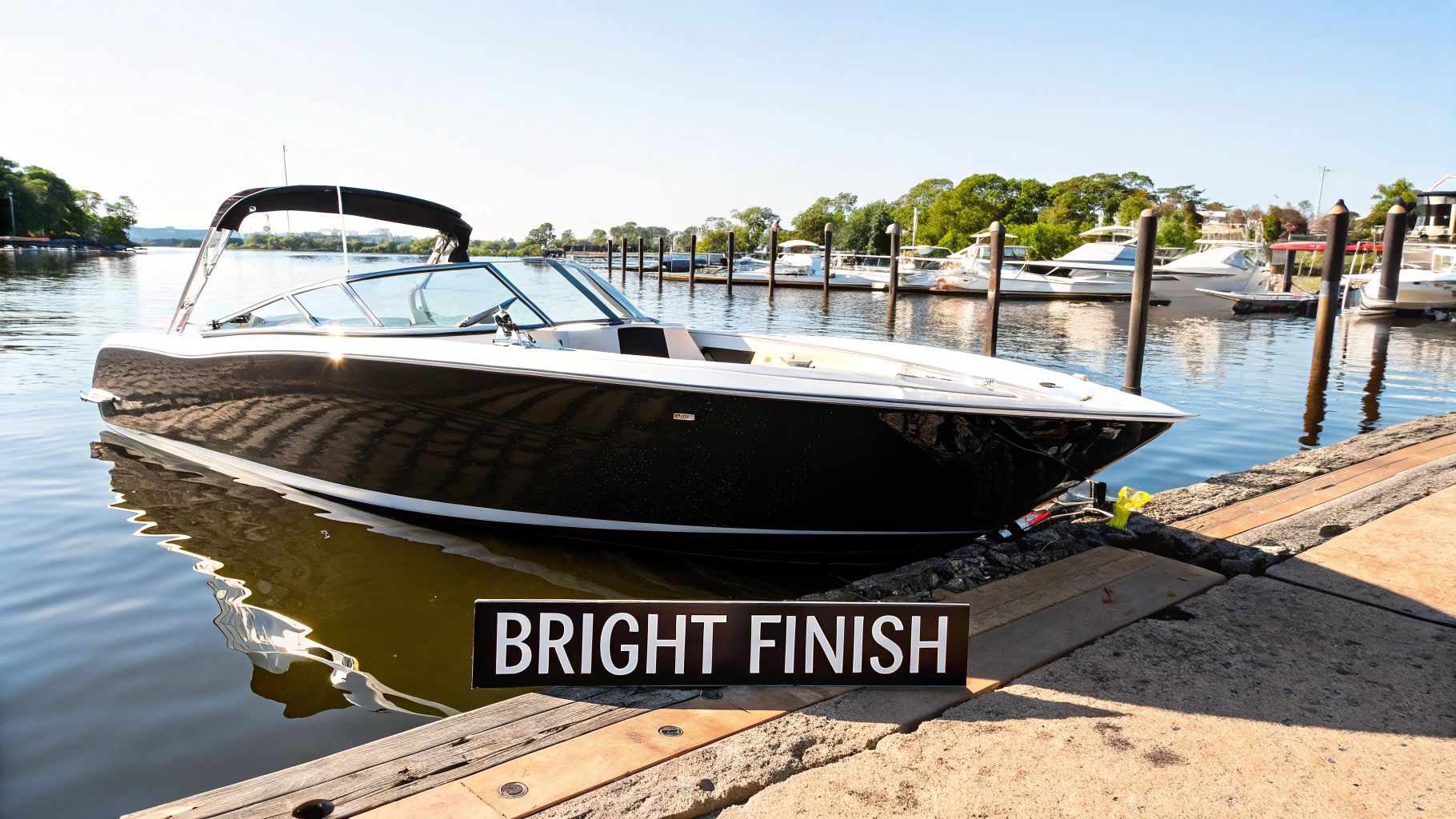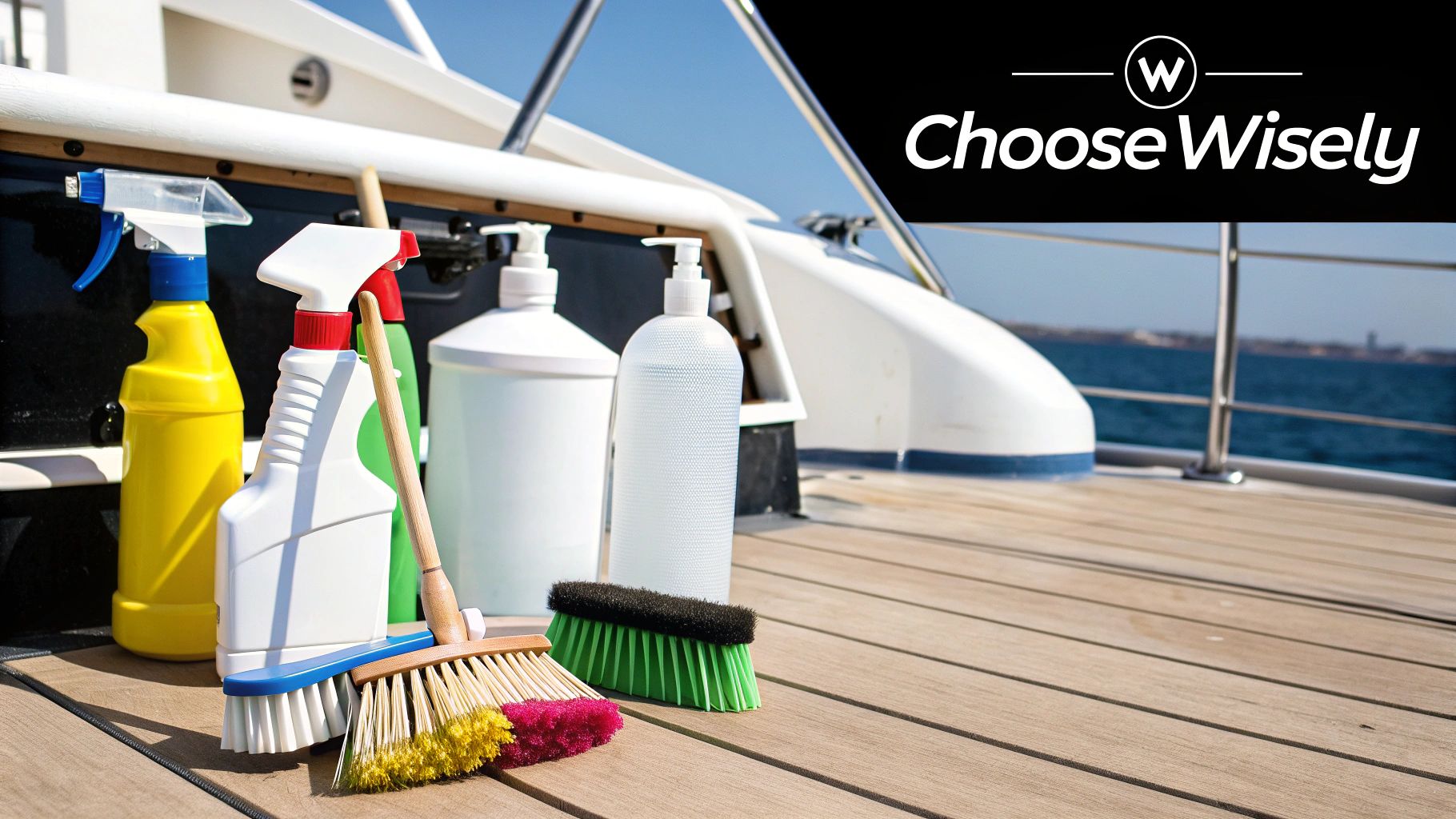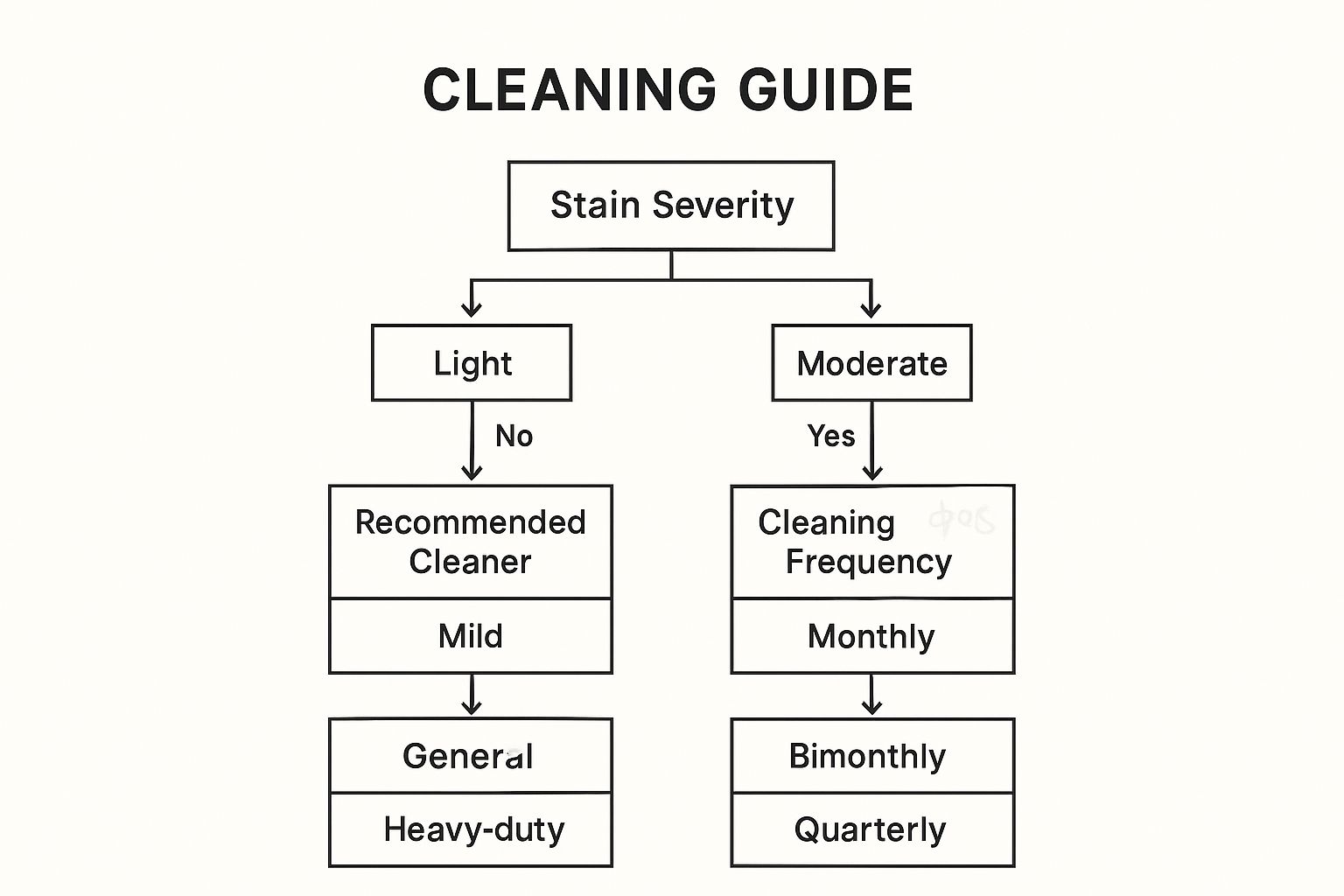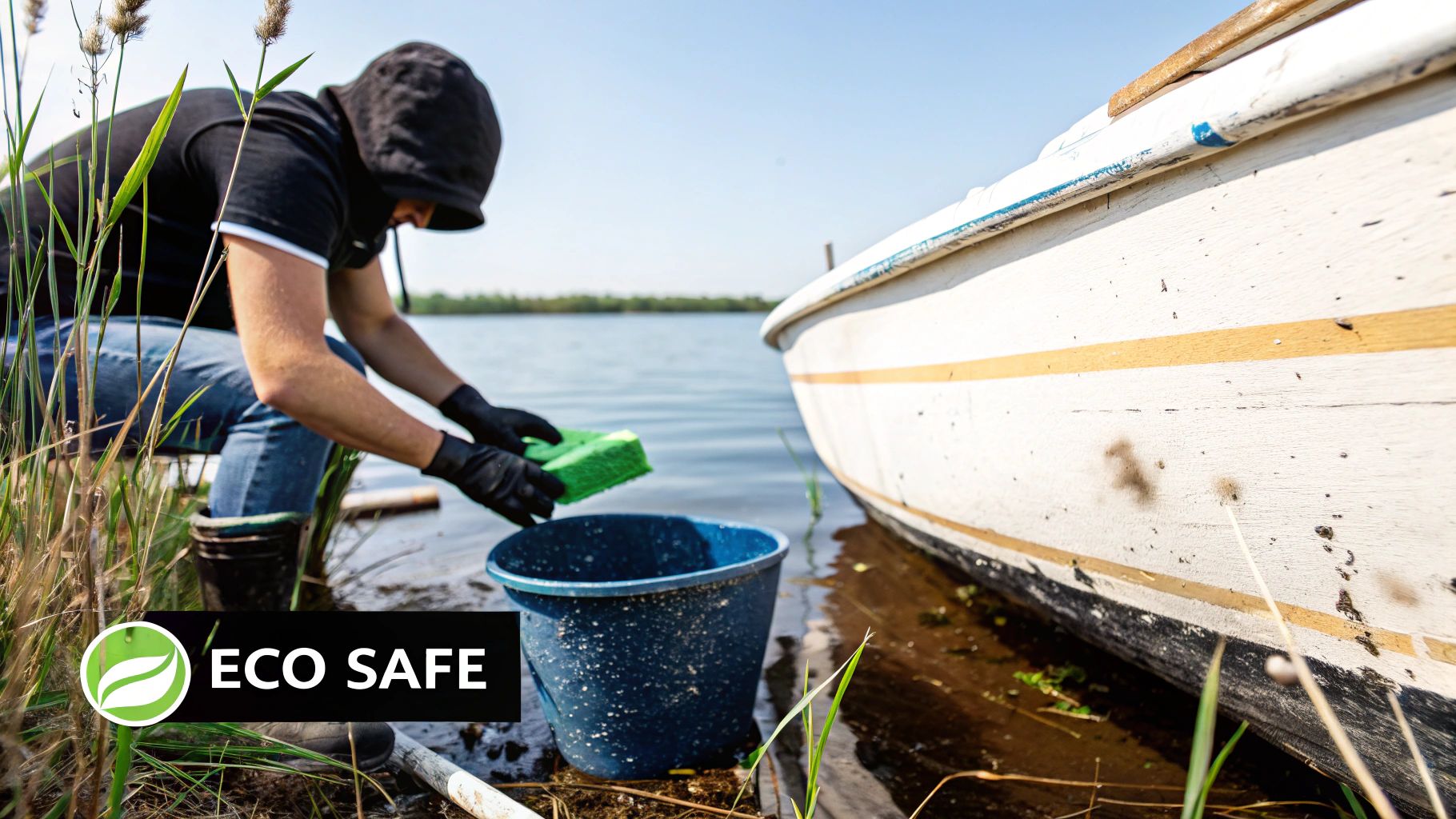Choosing the Best Fiberglass Boat Cleaner
A fiberglass boat cleaner isn't just another soap. It's a specific, non-abrasive formula crafted to tackle the unique grime, salt, and stains that plague a boat's gelcoat—all without stripping away its vital protective wax. Unlike harsh household cleaners, these products are your first line of defense, preserving your vessel's finish and preventing long-term damage from oxidation and UV rays.

Why Your Boat Deserves a Specialized Cleaner
Staring at the wall of cleaning products at the marine supply store can be intimidating. We all want that perfect, showroom shine, but the fear of picking the wrong product—one that could dull the finish or, worse, damage the gelcoat—is a real concern. This guide is here to cut through that confusion.
Think of your boat's gelcoat like the clear coat on a new car. You wouldn’t dream of washing your truck with dish soap, right? You know it would strip the wax and leave the paint exposed and vulnerable. The exact same logic applies to your boat. A dedicated fiberglass cleaner is engineered to be tough on grime but gentle on your boat's delicate surfaces.
The Big Mistake: Using All-Purpose Soaps
Grabbing a bottle of household detergent or an all-purpose cleaner is one of the most common—and damaging—mistakes a boat owner can make. These soaps are often highly alkaline and designed to aggressively cut through grease. They might get your boat clean for a moment, but they'll take the essential protective layers of wax right along with the dirt.
"A proper fiberglass boat cleaner is pH-balanced to lift dirt and grime without compromising the integrity of your wax or sealant. This simple choice is fundamental to long-term gelcoat health and maintaining your boat’s value."
This guide will walk you through choosing the right fiberglass boat cleaner and, just as importantly, using it like a pro. And you're not alone in this; the demand for proper marine care products is exploding. The global boat cleaner market was valued at a whopping $3.16 billion in 2023, a clear sign that owners are getting serious about protecting their investments. You can see more data on this growing market to understand just how big this trend is.
We're going to cover everything you need to know, including:
- The simple science that makes a great boat cleaner.
- How to match the right product to the right problem, from nasty hull stains to grimy, non-skid decks.
- A step-by-step process to get that professional-looking finish every time.
By the time we're done, you'll feel confident that you can keep your boat protected and looking its absolute best, season after season.
Understanding How Fiberglass Cleaners Work

It helps to think of your boat’s gelcoat like your own skin—it has pores and needs a gentle, effective cleanser, not some harsh detergent that strips away all its protective layers. Once you get the basic science behind how a good fiberglass boat cleaner actually works, you can see right past the marketing hype and pick a product that gives you a safe, brilliant clean every time.
The most important thing to look at is the cleaner’s pH level. Your boat’s finish is most likely protected by a coat of wax or a modern polymer sealant. Harsh, high-alkaline cleaners (like many household detergents) or super-acidic ones will chemically eat right through that protective coating. A pH-neutral formula is the way to go; it's designed to be tough on dirt but gentle on your wax and sealants, preserving the barrier that guards your gelcoat against nasty UV rays and oxidation.
The Chemistry of a Great Clean
Beyond the pH balance, the real magic comes down to a few key ingredients. Don't worry, you don’t need a chemistry degree to get it. The two heavy hitters in any quality cleaner are surfactants and chelating agents.
-
Surfactants: Picture these as tiny grime-fighting magnets. One end of a surfactant molecule loves water, while the other end grabs onto oil and dirt. As you wash your boat, these little guys surround every speck of grime, lift it off the fiberglass, and hold it in the water so it all just rinses away.
-
Chelating Agents: These are the specialists. They go after mineral-based headaches like stubborn hard water spots or those faint rust stains from your boat's fittings. Chelating agents latch onto mineral ions—calcium, magnesium, iron—and neutralize them, stopping them from re-staining the surface and letting them get washed away with everything else.
This one-two punch delivers a deep clean without having to use harsh, damaging chemicals. For a full rundown of the cleaning process from start to finish, check out our guide on how to clean a fiberglass boat.
Why Abrasives Are the Enemy
You’ll see “non-abrasive” printed on a lot of labels, and there's a very good reason for it. Abrasive cleaners are basically liquid sandpaper. They contain tiny, gritty particles that might muscle off a tough stain, but they also carve thousands of microscopic scratches into your gelcoat in the process.
Over time, these micro-scratches make the finish look dull, give dirt new places to cling to, and actually speed up the breakdown of the gelcoat itself. A top-tier fiberglass boat cleaner works with chemistry, not brute force, to lift stains safely.
Choosing a non-abrasive, pH-neutral formula packed with effective surfactants is the pro’s secret to keeping a flawless finish year after year. It gets the boat clean while preserving the very protection it needs to stay looking pristine.
Matching the Cleaner to the Grime
Choosing a fiberglass boat cleaner isn't a one-size-fits-all deal. Far from it. Grabbing a heavy-duty hull cleaner for some light deck dirt is like using a pressure washer to dust your living room furniture—it’s total overkill and can cause unnecessary wear on your gelcoat.
The real key is to play detective first. You need to correctly diagnose the type of grime you're up against and then select the cleaner that’s specifically formulated to defeat it. Think of it like a toolbox. You wouldn't use a sledgehammer to hang a picture frame, right? In the same way, the soap you use for a routine wash-down is worlds apart from the product you need to obliterate that stubborn brown "boat mustache" at the waterline.
Diagnosing Common Fiberglass Stains
Most of the ugly marks and stains you’ll find on your boat fall into just a few common categories. Figure out which one you're dealing with, and you're halfway to a clean hull.
- General Dirt and Grime: This is the everyday stuff—the light film of salt spray, dust, and environmental fallout that builds up after a day on the water. A simple, mild, pH-neutral boat wash is your go-to here.
- Black Streaks: Those frustrating black lines running down your hull are usually caused by water runoff from window seals, rub rails, or deck fittings. This runoff picks up pollutants and dirt, leaving a trail behind. You'll want a dedicated black streak remover for these.
- Waterline and Scum Stains: That classic yellow or brown stain clinging to your waterline is a nasty cocktail of algae, scum, minerals, and other marine growth. This calls for a more powerful, often acidic, hull cleaner.
- Rust Stains: See those orange drips coming from stainless steel fittings like cleats, screws, or railings? Those require a targeted rust stain remover, usually one containing special chelating agents to lift the stain out.
A classic rookie mistake is trying to scrub away tough stains with a general-purpose soap. This usually just leads to a lot of wasted elbow grease and can tempt you to scrub so hard you actually dull the gelcoat. Always match the chemical to the stain.
Selecting the Right Cleaning Product
Once you’ve identified the stain, you can pick the right weapon from your cleaning arsenal. This targeted approach isn't just more effective; it's also much safer for your boat's delicate finish.
It also explains a big trend in the boating world. More and more owners are looking for specialized solutions, not all-in-one "miracle" products. In fact, market forecasts predict the boat cleaner segment will grow from $410 million in 2024 to around $650 million by 2033. This growth is fueled by boaters demanding specific products from major players like Star Brite and 3M that are made just for surfaces like fiberglass. For a deeper dive, you can read the full analysis on the boat cleaner market.
The chart below breaks down how to think about this. It connects the type of stain you have with the right kind of cleaner.

As the graphic shows, it’s a simple relationship: as the stain gets tougher, the cleaner needs to get stronger. And, thankfully, the frequency of those heavy-duty cleaning sessions goes way down.
Fiberglass Cleaner Selection Guide
To make it even simpler, use this quick guide to pick the perfect cleaner based on the stain and surface you're working on.
| Stain Type | Recommended Cleaner Type | Key Ingredient to Look For | Application Caution |
|---|---|---|---|
| General Dirt, Salt | All-Purpose Boat Soap | pH-neutral surfactants | Safe for regular use on all surfaces. |
| Black Streaks | Black Streak Remover | Chelating agents, specialty surfactants | Test on a small, inconspicuous area first. |
| Waterline Scum | Hull Cleaner | Oxalic Acid, Hydrochloric Acid | Wear gloves/goggles; avoid contact with galvanized trailers. |
| Rust Drips | Rust Stain Remover | Oxalic Acid, Phosphoric Acid | Apply directly to the stain; don't let it dry on the surface. |
| Heavy Oxidation | Heavy-Duty Cleaner & Restorer | Mild abrasives, chemical cleaners | Follow up with a polish and wax to protect the restored surface. |
Choosing the right product from the start saves you time, effort, and protects your investment. A little diagnosis goes a long way in keeping your fiberglass gleaming.
Proper Application for Professional Results
Having the best fiberglass boat cleaner in your arsenal means squat if your application technique is sloppy. To get that professional, streak-free shine you’re after, you need a proven process. This isn't just about spraying some soap and hitting it with a hose; it's a method that sidesteps common mistakes and gets the most out of your cleaning products.
Think of it like painting a room. You wouldn't just grab a roller and start slapping paint on the walls without doing the prep work first, right? The same logic applies here. A methodical approach ensures you don't miss spots, create ugly streaks, or let soap dry on the hull—which leaves a hazy, frustrating film that’s a real pain to remove.
The Prep Work and Initial Rinse
Before you even think about cracking open your cleaner, get your setup right. Good prep is the foundation of a great wash.
- Gather Your Tools: You’ll need two buckets (one for your soap mix, one for clean rinse water), a soft-bristled boat brush or a good wash mitt, and a hose with a decent spray nozzle.
- Move to the Shade: This is a non-negotiable step. Washing your boat in direct, hot sunlight is a recipe for disaster. The heat makes soap and water evaporate way too fast, leaving behind stubborn soap scum and water spots before you even have a chance to rinse.
- Perform a Thorough Rinse: Give the entire boat a solid top-to-bottom rinse with fresh water. This first pass is crucial—it knocks off all the loose stuff like salt crystals, sand, and dirt, preventing you from grinding them into the gelcoat with your wash mitt.
The "two-bucket method" is a classic for a reason. By using one bucket for your fiberglass boat cleaner solution and a separate one to rinse your dirty mitt, you stop grit from being transferred back onto the boat's surface. This dramatically cuts down the risk of creating tiny micro-scratches in your finish.
The Washing and Rinsing Process
With the prep work done, it's time to get washing. The key here is to work smart, not just hard.
Start by mixing your fiberglass boat cleaner exactly as the manufacturer directs. Believe it or not, using too much soap won't make your boat any cleaner; it will just make it a nightmare to rinse off completely. Once your solution is ready, dip your wash mitt into the soapy water and get to it.
The golden rule is to work from the top down in small, manageable sections, about four to six feet wide. This strategy uses gravity to your advantage. As you clean the upper areas, the soapy runoff pre-soaks the sections below, helping to loosen grime before you even get there.
Wash one section, then immediately rinse it thoroughly before the soap has a chance to dry. Then, just move on to the next section. For tips specifically on those tricky non-skid areas, you can learn more about how to clean a fiberglass boat deck in our detailed guide. This top-down, sectional approach is the single best way to avoid streaks and get a flawless finish.
Protecting Your Finish After the Wash

Washing your boat with a quality fiberglass boat cleaner is a great first step, but it’s really only half the job. That deep clean creates the perfect, pristine canvas for the most important part of long-term maintenance: applying a protective coating.
Skipping this step is like washing and polishing your car but leaving off the wax. You’ve done all the hard work to make it shine, but you've left it completely exposed to the elements.
This two-part approach—a thorough clean followed by a solid layer of protection—is the real secret to keeping your boat’s value high and its gloss turning heads season after season. A good wash strips away all the grime and opens up the microscopic pores of the gelcoat. This is the absolute best time to seal that surface before new dirt and stains can get a foothold.
The Science of Sealing and Protecting
When it comes to protective coatings, you’ll generally find three main options. Each one works to create a tough, slick barrier that shields your gelcoat from the harsh marine environment.
- Traditional Waxes: Carnauba-based waxes deliver that deep, rich gloss many of us love. They offer good protection, but you'll find they need to be reapplied more frequently.
- Polymer Sealants: These are synthetic compounds that actually bond with the gelcoat on a chemical level. This gives them longer-lasting durability and fantastic UV resistance.
- Ceramic Coatings: This is the top tier of protection. Ceramic coatings form an incredibly hard, chemical-resistant shell that can last for years with the right care.
Whichever you choose, this protective layer becomes your boat’s first line of defense against the constant assault of UV rays, salt spray, bird droppings, and oxidation. The demand for better, more durable protection has pushed the industry forward, leading to innovations like nano-coatings and advanced UV-resistant sealants. These new technologies offer much longer-lasting defense for fiberglass, which is notoriously prone to sun damage and biofouling.
Think of your boat's gelcoat like a crisp, white t-shirt. A good wash gets it clean, but a protective sealant is like adding a layer of invisible Scotchgard. It doesn’t just keep the shirt looking clean; it actively repels future spills and stains, making the next wash a whole lot easier.
By following up a thorough wash with a quality wax or sealant, you're doing more than just making your boat look good for the weekend. You're actively preserving its structural integrity and resale value. For more essential advice on keeping your vessel spotless, check out our comprehensive boat wash tips for a detailed walkthrough. This simple but vital routine is what separates a well-maintained boat from one that shows its age way too soon.
Choosing an Eco-Friendly Boat Cleaner
As a boat owner, you’ve got a special connection to the water. It’s on all of us to protect our marine ecosystems, and that responsibility starts right on the deck with the products we let run off our hulls. Choosing an eco-friendly fiberglass boat cleaner is a powerful way to keep your vessel looking sharp without harming the very environment you love.
Many old-school cleaners get their power from harsh chemicals like phosphates and volatile organic compounds (VOCs). When those chemicals hit the water, they can wreak havoc on delicate aquatic life, trigger nasty algae blooms, and just generally degrade water quality. Thankfully, modern biodegradable formulas get the job done just as well without all the damaging fallout.
Identifying Truly Green Products
The word "green" gets tossed around a lot, so you need to know what you're actually looking for. A genuinely eco-friendly fiberglass boat cleaner isn't just about marketing—it has specific, verifiable qualities.
- Biodegradable Formulas: This is the big one. It means the cleaner's ingredients are designed to break down naturally into harmless bits and pieces, not hang around in the water causing problems for years.
- Phosphate-Free: Think of phosphates as fertilizer for algae. A big dose of them in the water leads to destructive blooms that suck all the oxygen out of the water, which is devastating for fish and other marine life.
- Neutral pH: Just like with any good cleaner, a neutral pH is kinder to your boat’s wax and sealants. But it also means it’s less disruptive if a little gets into the waterway.
The good news is that the market for these responsible products is absolutely booming. The global boat hull cleaner industry, a huge chunk of which is for fiberglass, was valued at around $500 million in 2025. It's projected to explode to $2.5 billion by 2033. This massive growth is being pushed by new environmental rules and a simple, growing demand from boaters like us for stuff that works and is good for the environment.
When you choose a biodegradable, phosphate-free cleaner, you're making a conscious decision to be a steward of the environment. You’re proving that a beautiful boat and a healthy marine ecosystem can go hand-in-hand.
This commitment is becoming a core part of the boating world. To get a bigger picture of how the whole industry is shifting, you might find more on eco-friendly marine operations pretty insightful. By picking your products with a little care, you’re doing your part for a cleaner, healthier future on the water.
Got Questions About Fiberglass Cleaners? We've Got Answers
Every boat owner runs into the same questions when it comes to keeping their fiberglass looking sharp. Let's cut through the confusion with some straightforward answers to the most common queries we hear.
Can I Just Use Dish Soap on My Fiberglass Boat?
It's a question we get all the time, and the temptation is understandable. But grabbing that bottle of dish soap from the kitchen is one of the worst things you can do for your boat's finish.
Household detergents are designed to be aggressive grease-cutters. On your boat, that means they won't just lift dirt—they'll completely strip away the protective layer of wax on your gelcoat. Without that wax, your hull is left exposed to harsh UV rays and oxidation, which is a fast track to that dreaded chalky, faded look.
Stick with a dedicated, pH-balanced fiberglass boat cleaner. It's formulated to clean effectively without compromising the protection you've worked so hard to apply.
How Often Should I Be Washing My Boat?
There's no single right answer here—it really comes down to where you boat and how often you're out on the water.
- Saltwater Boating: If you're in the salt, a thorough freshwater rinse after every single trip is non-negotiable. Salt is incredibly corrosive. Beyond that, plan for a full wash-down with a proper cleaner at least once a month during your prime boating season.
- Freshwater Boating: For those on lakes and rivers, or who use their boat less frequently, a deep clean every one to two months is usually plenty to keep it looking great.
The real secret is consistency. Staying on top of it prevents grime from baking on, making each future wash a whole lot easier.
Think of it this way: a few minutes rinsing off salt spray after a day on the ocean saves you hours of back-breaking scrubbing later. It’s the best return on investment for your time you can get.
What’s the Real Difference Between a Cleaner, Polish, and Wax?
It's easy to get these terms mixed up, but each product has a very distinct and crucial job. They aren't interchangeable.
- Cleaner: This is your soap. Its only job is to get the surface clean by removing loose dirt, salt, grime, and other fresh contaminants from your fiberglass.
- Polish: Think of polish as a specialized skin treatment for your boat. It contains very fine abrasives that gently buff out light oxidation, minor scratches, and those annoying swirl marks. It restores the luster and shine to the gelcoat itself.
- Wax/Sealant: This is your boat's sunscreen and rain jacket, all in one. It doesn't do any cleaning. Instead, it lays down a purely protective barrier over the clean, polished surface, shielding it from UV damage and grime while giving you that final, brilliant, high-gloss shine.
For all the premium products you need to keep your vessel in top condition, from specialized cleaners to durable waxes and sealants, trust Better Boat. Explore our full range of easy-to-use maintenance solutions at betterboat.com.




